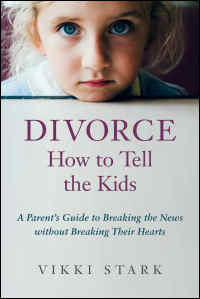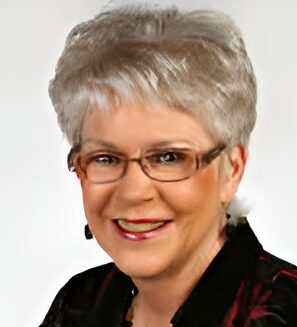Author Vikki Stark Conducts Over 100 Interviews With Children For New Book About Separation And Divorce
 Vikki Stark, a divorce recovery specialist and a family therapist for over thirty (30) years, published this book in 2015. Her stated purpose in writing the book was to make the “telling” to the children of the news that a family was going to be separating as non-traumatic as possible. To research this subject area, the author conducted over one hundred (100) interviews with children and with adults who were children when their parents separated and divorced. She also interviewed parents who had already done the “telling” to their children to learn about their positive and negative experiences in doing so. Finally, she read and researched many articles written by other professionals in the same field.
Vikki Stark, a divorce recovery specialist and a family therapist for over thirty (30) years, published this book in 2015. Her stated purpose in writing the book was to make the “telling” to the children of the news that a family was going to be separating as non-traumatic as possible. To research this subject area, the author conducted over one hundred (100) interviews with children and with adults who were children when their parents separated and divorced. She also interviewed parents who had already done the “telling” to their children to learn about their positive and negative experiences in doing so. Finally, she read and researched many articles written by other professionals in the same field.
The main points from Chapter 1, A Bridge to Your Next Life, are as follows:
- You cannot avoid the anger or sorrow that your children may feel; but you can learn skills to reduce the trauma.
- You must become “attuned” to your children’s emotions. Attunement means listening carefully to what they are saying, acknowledging and accepting their feelings.
- Hearing or reading the actual words of children who have experienced separation will sensitize you to appreciate what your own children need at this time.
Hearing or reading advice from parents who have done the “telling” to their children will be informative for the reader.
In Chapters 2 and 3, the author addresses the emotional issues surrounding separation and divorce and described techniques for managing the emotions one or both parents may experience. Certainly, the emotions of the person who is the “initiator” of the divorce may be quite different from the emotions of the person who is being left (the “leavee”).
In Chapter 4, the author discusses the issues involved with The Planning Meeting wherein both parties address the following:
- Who is going to break the news?
- Where and when will the telling take place?
- What reason will be given for the separation?
- When will the actual separation take place?
- What are the plans for separate living arrangements?
- What can the parents do to be certain they are attuned to the feelings and emotions of their children?
In Chapter 5, What Divorce Means to the Kids, the author describes the reactions of children to the following major life changes:
- Their parents will no longer be a married couple.
- They will no longer be living together in the same place.
- They probably will not see both parents each day.
- They may not continue to live in the same house or apartment or to attend the same school.
- As a consequence of the foregoing facts, the children may feel one or more of the following emotions: anger, guilt, shame, insecurity, anxiety, fear, shock, or sadness/sorrow.
In Chapter 6, Will Your Child See It Coming, she discusses whether or not your child will be surprised with the news of the pending separation. She describes three (3) types of marriages often leading to separation:
- The Openly Hostile High-Conflict Household.
- The Well-Contained High-Conflict Household.
- The No-Conflict Household.
The last identified marriage type often ends abruptly and dramatically when the departing spouse leaves with little warning. This breakup is most devastating to the deserted spouse and the children as they had little to no notice that the desertion/separation was going to take place.
Chapters 7 and 8 address the questions of “Who” should do the telling and the questions of “Where” and “When” to do the telling. Ideally, the telling should be synchronized with both parents participating in the telling in a friendly and civilized manner. If there is too much tension and conflict for the parents to be in the same room at the same time, the telling could be done in tandem with one parent talking to the children alone followed by the second parent talking to the children alone. Solo telling, by one parent alone, may be necessary if one parent has abandoned the family, has problems with mental illness, or has addiction problems with drugs or alcohol. “Where” to tell the children is best answered by where do you typically or normally get together to talk about things. It may be the kitchen table in the kitchen or the dining table in the dining room or the family room. The place should be comfortable for the children.
Choosing “when” to do the telling is strategic. The parents should try to avoid the telling while one party is still in a highly volatile or emotional state. And, the telling should not occur on a child’s birthday or a special holiday such as Thanksgiving or Christmas. The parents should permit the children to have normal celebrations and let the telling take place after special days of significance for the children.
Chapter 9 addresses the issue of honesty. The children who participated in the author’s research study wanted honesty from their parents. But, that honesty must be tempered with protection from harm. Parents should only reveal those details that the children can understand. Obviously, an adolescent child could receive and understand more details than a very young pre-school child.
In Chapter 10, Affairs and Blame, the author focuses upon two very sensitive and emotional issues as one party’s affair often leads to the demise of the marriage. Although the deserted parent may want to tell the children about their Father’s affair and blame him for all negative outcomes, the damage done to the parent-child relationship may never recover. Again, the author encourages the deserted party to put the children and their needs first. If the children need to know, the deserted parent should tell them who asked for the separation without demonizing the parent to the child.
Chapters 11 and 12 set forth the specific steps for the parents to take in the actual telling to the children. Those six (6) steps are as follows:
- Preparation for the telling-Setting forth the “stage” for the children.
- Revelation of the facts-There is going to be a separation of the family.
- Assessing the emotional response of the children and being attuned to their reactions.
- Parents’ Response-Give the children time and space to react. Accept what the children are saying to both of you. Do not lecture or chastise the children for what they are expressing. This is a very emotional time for them.
- Provide concrete plans and information to the children. Where will they be living and with whom will they be living? Will their schools change or remain the same? When will they see the other parent?
- Question and answer session: Permit the children to express their anger, fears, and sorrow. Accept their feelings. Ask questions to determine if they understood what they were told in the “telling”
Chapter 13, Reducing the Risk of Trauma, reflects that an unexpected result of the study is the realization that the telling of the impending separation and divorce may result in a clinically diagnosable traumatic response in a child or children. There may be a definite need for counseling in a therapeutic setting to help the child or children adjust to the perceived changes or losses in their lives.
Chapter 14, The Attuned Response, sets forth the two steps to resolve the emotional hurt incurred by the telling of the separation/divorce:
- Release emotions.
- Engage logic.
Why? The emotions have to come out and be dealt with before logic can “kick in” and become apparent.
Chapter 15, Strategies for Staying Attuned After the Telling, is the final chapter of the book. The author strongly encourages both parents to carefully observe and interact with their children. Ask open-ended questions of them to increase their responses. For example, if you ask “How are you feeling?” you might get a one word response such as “Fine!”. But if you ask, “It’s been more than a week since Daddy left, how has it been for you with his not living with us anymore?” Hopefully, you will get more than a one word response. Parents are encouraged to use puppets for role-playing or art projects to encourage the children to discuss what is really going on with their thoughts, feelings, and emotions.
The second theme in this last chapter involves the hard work needed to create a “Functional Co-parenting Relationship” with your former spouse. You may no longer be Husband and Wife to one another but you will always be the parents of your children. The better you are at co-parenting, the better it will be for the children.
I thoroughly enjoyed the book and shall encourage my clients to read the book. I kept wishing that my son and former daughter-in-law had had the book available to them at the time of their separation and divorce, but the book had not been written in 2007-2008. I also appreciated the Appendices at the end of the book:
Appendix A: Questionnaire for Adults Whose Parents Divorced When They Were Children or Teens
Appendix B: Questionnaire for Children Up to Age 13
Appendix C: Questionnaire for Teens
Appendix D: Questionnaire for Parents Who Have Already Told Their Children About the Separation.
Also, the author had a Recommended Reading List for Parents and an extensive bibliography of books and articles that she had used to write her most interesting and helpful book.
‘Divorce: How to Tell The Kids: A Parent’s Guide to Breaking the News Without Breaking Their Hearts’ By Vikki Stark – Purchase Link and Additional Information For Parents and Children Facing Family Separation
If you are interested in purchasing a copy of this book about children, parents, separation and divorce, click on http://howtotellthekids.com/
© 2015 – 2018, Ohio Family Law Blog. All rights reserved.

Anne Shale is of counsel to Dayton, Ohio, law firm, Holzfaster, Cecil, McKnight & Mues. She is a former registered nurse and concentrates her practice in Family Law and Divorce cases.


